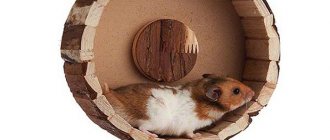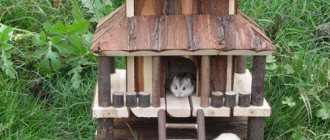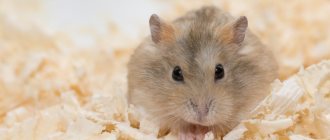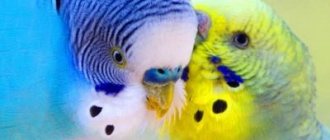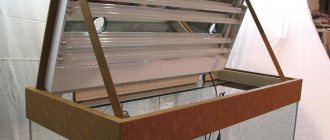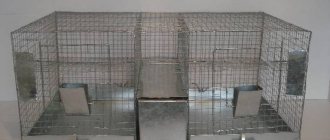Hamsters are active animals that need regular movement. That is why a system of labyrinths will be great entertainment for them - you can make a tunnel for a hamster yourself in a couple of hours.
Let's find out what available materials can be used to build such an attraction for your pet, as well as what requirements must be observed during the manufacturing process.
Cardboard labyrinth
This material is well suited for making structures. It is affordable and easy to use. Even children can make a cardboard craft. It is necessary to think over the layout of the labyrinth with dimensions in advance.
To make your task easier, you can use a cardboard box as a blank. In this case, you only need to make internal partitions and obstacle parts. The height of the box should be 20–30 cm, the width and length - the larger, the more interesting it will be for the hamster to walk.
Article on the topic: House for a hamster: choice, arrangement, materials (photo)
For work you will need materials:
- cardboard box,
- cardboard,
- pencil,
- ruler,
- stationery knife or scissors,
- double-sided tape or glue gun.
- Using a pencil, draw a diagram of the labyrinth on the bottom of the box, along the lines of which future elements will be attached.
- Make internal partitions. Using scissors or a stationery knife, you need to cut out the walls of the labyrinth 15 cm high from cardboard. Some holes should be made for tunnels.
- Install partitions. Glue the cardboard maze walls to the lines on the bottom of the box using double-sided tape or a glue gun. You can mount walls that correspond to the width of the box, having previously made holes in them for entry and exit. You can also make partitions from small pieces of cardboard in any order.
- If desired, attach tunnels (rollers from toilet paper or foil).
- Place additional elements. In areas free from partitions, install a running wheel and bridges. The latter can be made using cardboard or ice cream sticks.
- If you want to decorate the entertainment complex: cover the walls with colored paper, draw windows and doors with markers.
You should not leave your hamster unattended in a cardboard maze. Having had enough exercise, the pet can chew through the cardboard and escape.
Single-story or multi-story: what to choose?
The classic option is a one-story metal cage. It is easy to disassemble, convenient and quick to clean. This design can be additionally equipped with a tunnel or pen: the dwarf will have more room to run.
The second option is a cage of several floors. For such a house there are a number of additional requirements.
Cparks/Pixabay
The distance between floors is from 17 to 25 cm. If the height is more than 30 cm, the level of injury risk increases.
The floor must be solid plastic, since food, bedding and the rodent’s paws will fall through the grate when running
Please note that the cages have height-adjustable tiers.
So which option is better? It is recommended that Djungarian hamsters choose single-story cages with a large area. Individuals love jogging and free space. This is much more interesting for them than climbing or climbing up bars.
Plywood building
Creating a labyrinth from plywood will take more time than structures made from other materials, but the result is worth it. It will last much longer than its counterparts.
To make the design you will need:
- plywood,
- ruler,
- pencil,
- electric jigsaw,
- PVA glue.
- Make a box out of plywood. It is necessary to cut out the bottom of the desired size and four walls 15–20 cm high. The edges of the base should be greased with PVA glue and the walls should be installed on it.
- Prepare 3-4 long internal partitions. Their length should correspond to the width of the box. It is necessary to make round holes on one or two edges of each wall so that the hamster can crawl through them.
- Make 11–14 small partitions that are installed between the long walls and perpendicular to them. Holes should also be made in them.
- Sand the sharp edges of the parts using fine sandpaper.
- Form a labyrinth. Apply PVA glue to the edge of the partition and press it to the base of the box. Repeat the action with the remaining walls.
- Excess glue on the plywood should be blotted with a napkin.
- The structure can be covered with a sheet of plexiglass, leaving a small gap for air to pass through. This will prevent the hamster from escaping.
Article on the topic: Toys for guinea pigs: ready-made and homemade (photo)
What makes a guinea pig sick?
Guinea pig diseases can be caused by infections, genetic predisposition, or improper care and maintenance of the animal.
Incurable diseases for which the animal must be euthanized:
- Plague.
The disease is dangerous for other animals. Its symptoms are weakness, apathy, lack of coordination and paralysis.
- Lymphocytic choriomeningitis.
The disease is dangerous not only for other animals, but also for humans. With symptoms such as difficulty breathing, fever above 39.5 degrees, pleurisy, convulsions, the animal must be urgently taken to the veterinarian.
- Pasteurellosis.
An incurable disease that is dangerous to other animals. Its symptoms: purulent nasal discharge, ulcers, wheezing when breathing, convulsions.
- Pseudotuberculosis entails paralysis of the limbs. Therefore, if diarrhea, refusal of food or exhaustion occurs, the animal should be urgently taken to a doctor.
- Parafit. Its symptoms: diarrhea, refusal to eat, apathy.
In addition, pigs suffer from colds, rickets, conjunctivitis, infection with parasites (both internal and external), hair loss (alopecia), malocclusion, diseases of the digestive tract, and fractures.
The following symptoms are reasons to be wary and closely monitor the animal, or even take it to the veterinarian:
- lethargy;
- depression;
- unkempt fur;
- discharge;
- problems with going to the toilet and dirt near the anus.
The tips for caring for a guinea pig described in this article and preventive visits to the veterinarian will help avoid some diseases that can become chronic and harm the animal if left unattended.
Tunnel made of plastic bottles
Hamsters love closed spaces, similar to burrows. Therefore, plastic bottles are ideal for making a walking maze. In addition, this material is affordable and safe. You just can’t use containers from household chemicals, so as not to harm your pet’s health.
To work you need:
- plastic bottles of any capacity,
- stationery knife,
- scissors,
- insulating tape,
- scotch.
- Wash and dry the bottles thoroughly and remove the stickers from them.
- Take one container and make two holes on its opposite sides. The large hole should be equal to the diameter of the bottle, the small one - its neck. To do this, you need to make a cross in the wall of the bottle with a knife, and then finish the job using scissors.
- Cut a hole near the neck of the second container. Its size should be sufficient for the hamster to pass freely. The sections should be wrapped with electrical tape to prevent the rodent from injuring its paws while running.
- From the second container, you need to unscrew the cap and insert the bottle neck through the large hole, and then through the small one. Then you need to tighten it again.
- In a similar way, you should lengthen the tunnel to the desired size. If desired, you can also make several spacious areas using five-liter bottles. One platform is for a running wheel, the second is for a drinking bowl and feeder, the third is for a container with sand or toys. And of course, you need to remember to cut an entrance hole for the hamster.
A rodent can stay in such a maze all day. You just need to use an awl to make several holes in each bottle. This will ensure air renewal, which is important for a pet spending a long time in a confined space.
Delicious "walnut" staircase
From the empty shells of several walnuts you can make an excellent toy for your pet. In addition to the empty shell halves, you need to prepare in advance:
- a thin nail with a sharp end;
- hammer;
- a strong thread as long as the height of the cell;
- medium size washer.
In all prepared half-shells, you need to carefully make a hole in the center. This is done by driving a nail (there is no need to leave it in the resulting hole). You need to thread a thread through the holes to make the shells into a kind of beads. An important nuance - all halves must be turned in one direction, with the exception of the last one. In a vertical position, the beads look like a stack of bowls standing on a tubercle.
A washer is tied to the end of the thread coming out of the last (lower) shell so that the thread is securely fastened and the structure does not fall apart. The upper end of the thread is tied to the “ceiling” of the cage so that the lower shell lies on the bottom, but the “beads” do not sag. You need to put treats for the hamster in all the resulting bowls. Climbing the structure, the pet will take away a tasty prize at each stage of “conquering the peak”.
The height of the structure must be respected. Hamsters climb beautifully, but they descend simply by jumping. Therefore, you should not use shells from more than several nuts for one construction.
In addition, it is important to provide your pet with a soft landing - the bedding in the area of the toy should be thicker
What else can you make a labyrinth from?
With the help of your imagination, you can find a lot of materials in your home from which you can build an entertainment center for your pet.
From a toy constructor
Most often, hamsters appear in a house where there are children. This means that there is a toy constructor from which you can make a colorful playroom for your pet. This building material makes it possible to come up with many solutions. From it you can build a whole labyrinth town: streets, turrets, arches, bridges, passages with second floors. Small plastic toys will perfectly complement the structure.
Article on the topic: Cage for the Djungarian hamster, housing for the Djungarian hamster (photo)
Among the advantages of a labyrinth made from a construction kit is the ability to quickly change the route. In a matter of seconds, you can rearrange several parts, and the hamster will have to re-create the optimal path. Stimulating mental activity will benefit the animal.
From plumbing pipes
Of all the labyrinth options, this one is considered the most expensive. But if after the repair there are still free plumbing pipes, then they can be used for entertainment for your beloved pet.
Modern products are made from non-toxic plastic, so they are safe for the animal. The pipes are threaded, making them easy to disassemble and reassemble. You can improve the design at any time.
Transparent tubes make it possible to watch the hamster's wanderings, which is very exciting. But the pets themselves prefer dark tunnels, as in natural conditions. To please both the pet and the owner, you can combine two types of plumbing pipes in the design.
From books
Old books are also suitable for creating a labyrinth. To do this, you need to place them with their roots facing up. With the help of books, treadmills with a running width of 5–10 cm are formed. It is also advisable to fence the labyrinth with books so that the pets do not run away.
Children love to have hamster races in these book forts. The race participants are released from the cage and see who gets to the finish line first. At the exit, the winner should receive a reward in the form of a treat.
Also, when making a maze for a hamster, it will be interesting to combine different materials. For example, connect cardboard or plywood with plumbing pipes, and a children's construction set with books.
You don't have to spend money to keep your hamster happy and healthy. To do this, you only need imagination and simple materials at hand, which everyone certainly has. In addition, a handmade craft is always more valuable.
Preparing for a Guinea Pig
Before you bring a new pet into your home, a home must be arranged for it. Even before purchasing a cage, you need to choose a place where the cage will stand. Pigs do not like excessive heat and drafts, so it is better to choose a place for your pet away from radiators and windows.
In addition to the cage, the pig needs: a drinking bowl, a feeder, bedding, a resting house, a comb for long-haired breeds, scissors or tweezers for caring for claws, food, hay for nutrition, toys and a carrier for visiting the veterinarian.
After the pig and the owner get used to the new life and new responsibilities, accessories for entertainment can be made or purchased additionally. Your pet will need new entertainment.
How to make a maze and tunnel for a hamster with your own hands
A labyrinth for a hamster is a kind of exciting game for logic, intelligence and resourcefulness. The original attraction also plays the role of a simulator, like a running wheel - while the hamster wanders through the corridors of the labyrinth, it stretches its legs no worse than in a wheel. So that the rodent does not get bored and his leisure time is interesting and useful, it is worth providing him with such a toy. You can purchase a ready-made labyrinth at a pet store, but even better is to make an entertainment complex for the animal yourself. Then the pet will have a unique toy designed specifically for him. This is not difficult to do, but your pet’s joy will know no bounds.
Article on the topic: Filler for hamsters: which one is better to choose (sawdust, paper and other types of bedding)
A little about ferrets
Recently, more and more often animal lovers choose a ferret as a pet. This animal is very funny, cute and to some extent exotic. And this choice is quite logical. Firstly, ferrets are very cheerful creatures, you won’t get bored with them, there is no end in sight to the games and fun. Secondly, the ferrets are very compact, for some this is a significant advantage, since they can be very easily transported on various trips.
Ferrets, despite the fact that they are nocturnal animals, can quite easily adapt to the life rhythm of their owner. There is no need for daily walks with these animals, like, for example, with dogs. If you decide to take your ferret for a walk, getting him accustomed to a harness won’t cause much trouble. They treat the owner friendly, get used to it well, unlike cats, but without fanaticism, like dogs. It is also worth noting that ferrets are distinguished by their extraordinary inquisitiveness of mind, intelligence and cunning.
Among representatives of the same species, you can find animals with completely different manifestations of character, therefore, you can choose a more suitable type for yourself, from super active to calmer.
Why do hamsters need toys (maze, tunnel)
Rodents living in nature lead an active lifestyle. When getting food, they cover a distance of over 10 km. Energetic and nimble wild hamsters create dwellings deep underground, which are a kind of complex of rooms and corridors. Orientation in these complex structures is not a problem for them. Hamsters tirelessly run along the corridors of dug housing from end to end.
Life at home as a pet is completely different. There is no need to look for food, there is no need to build a home, there is no need to run away or hide from enemies. The home is safe and cozy, food is served ready-made and in sufficient quantity. The owners look after and care for him.
Domestic hamsters are always fatter than their wild counterparts. Lazy and pampered “household members” prefer not to move or strain once again. A minimal level of activity and lack of movement in an animal leads to obesity. To ensure that living in a luxurious home environment does not harm your pet’s health or shorten its lifespan, it is necessary to provide your hamster with exciting leisure time accompanied by physical activity. The best option is walking through labyrinths and tunnels.
PROJECT MYSHKO - sample testing
We used two mice as maze testers, which Martin, the rodent owner, fearlessly donated for this purpose.
Yes, Martin also has a cat living next to the mice at home. And here are our testers!
The mouse den is assembled and ready for testing.
Natural curiosity makes itself felt, and the brave explorer enters the hole.
The entrance bottle seems narrow at first glance, but the mouse can easily turn around in it.
The second tester decided to break the agreement and tried to leave the laboratory.
Meanwhile, our first, bravest mouse was already exploring the unusual hole with all his might.
It looks like he smelled the cheese we left in the feeding block.
Yes, the mission was successful.
But the research didn't end there.
The bottles turned out to be not as tasty as the cheese.
I couldn’t get through the neck, but it’s still interesting what’s on the other side.
As soon as the feeder was removed, a curious tester was right there.
By the way, the labyrinth can be disconnected from the cage, just don’t forget to close the front door
